




Flights from Jacksonville to Newark & from Newark to Oslo went as advertised. Jacksonville plane was small and not very comfortable for legs; SAS to Oslo was comfy physically but seemed long since neither of us could sleep on board very effectively. Therefore, after 6 hrs. and 20 minutes, when we arrived in Oslo to rain and overcast skies, we weren’t disappointed because that’s how we felt.
Got to the Hotel Continental by about 9:30 AM (3:30 EST July 6) and were very relieved to find that we could get into our wonderful room! The hotel is across the street from the National Theatre which is fronted by a statue of Norway’s most illustrious playwright, Henrik Ibsen. We fell into the beds and slept until 2 PM when we got up to join the group for the 3 PM city tour. The ride into Oslo from the airport was remarkable only for the greenness of the land and the excellence of the road (which the guide assured us was unique in Norway). We were really too gray ourselves to notice much more than the neat farms and the red barns along the way. However, our friendly guide did tell us that Norway is almost 60% mountainous and only 4% arable land. Forests cover significant portions of the land as well.
Our guide to the city tour was Margareth and she spoke good English with a decidedly British accent. She was a small woman with gray hair who was very enthusiastic about Norway and its history. By now the sun had won the battle with the clouds and everything was bathed in glorious northern light. The city was vibrant in its glow and the so-pale Norwegians were everywhere enjoying their parks and pedestrian streets, many in quite abbreviated outfits. People watching in the parks was fascinating since there were so many types of dress to be seen as well as a surprising ethnic variety: the white breads, several black folks, and Pakistanis who have been here for several years after having immigrated to find jobs. Norway has welcomed them and their families so many have stayed and made their homes here. Don’t know yet why we saw so many black children in the parks.
Oslo appears to be a quite livable city, with plenty of walking space, lots of trees and parks, many pedestrian streets and lanes. The architecture is different enough to merit its own Norwegian designation, since it seemed unlike Swedish or Danish or Icelandic, except in its multicolor houses and castles. Most of the housing is wooden, though the official and royal buildings are stone or brick. Flowers are obviously much loved here and flourish everywhere.
We learned a little Norwegian history from Margareth chiefly that Oslo was founded in 1000 AD and burned 17 times before the core of the present city was built in the 16th century. For three hundred years, Oslo was called Christiania in honor of the Danish King Christian IV who actually lived in the city and revitalized it during the 1600s. Until the 1500s, Norway was independent, then it was conquered by Denmark and ruled as part of the Danish realm. Later, Norway became part of a Swedish union and was governed
through that country’s monarchs and parliament. Only in 1905 did Norway become an independent country. It is now governed by a constitutional and hereditary monarchy, descended from Jean-Marie Bernadotte and Desiree of Napoleonic fame.
Our city tour drove us by the Royal Palace, the Royal Gardens, even the royal barns and cows as well as the King’s Summer Residence. We also saw the Akershus Fortress dating from 1200s which was never conquered. Though started as a royal dwelling, it became strictly a fortress in 1582. It is now the scene of festivities, official rites and visits from other heads of state as well as a park which can be visited and enjoyed by the Norwegians and their many tourists from other countries. However, not by us, since there was not sufficient time. The Town Hall is the site for the awarding of the Nobel Peace Prize, won by Jimmy Carter last year. It has an impressive entrance between two square towers, reminiscent of Viking days.
We did emerge from the buses to see the Vigeland Sculpture Garden in the Frognerpark.

Gustav Vigeland was Norway’s most famous sculpture and did create a monumental legacy for the country, with the government’s economic support. It was finished in 1942,
having been started 30 years previously. There are about 200 different statues and a magnificent monolith showing human beings striving for resurrection from death to life. The other important pieces decorate the bridge and are wonderful depictions of nude human beings in all age groups from infants to dead bodies, in all kinds of gatherings, whispering, giggling, wrestling, debating, courting, struggling, etc. Much emphasis placed on family life and the circular nature of life itself. The statues are life-size and larger and carved of granite. The stone has been polished so that it feels quite silky and it is amazing to feel ribs and spines when you touch the statues (which you are encouraged to do) because often those features are not obvious to the eyes. A theme of many of the statues is man in relationship to the tree(s) of life and often the figures are depicted within the “toils” of trees or climbing in them and out of them. Again, everybody from babies to old folks are found within the “cages” of these tree sculptures. Very impressive and quite a beautiful setting as well.

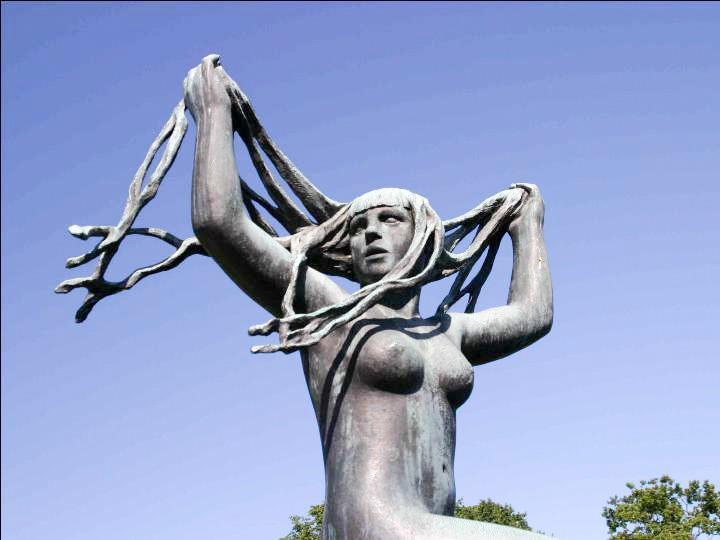






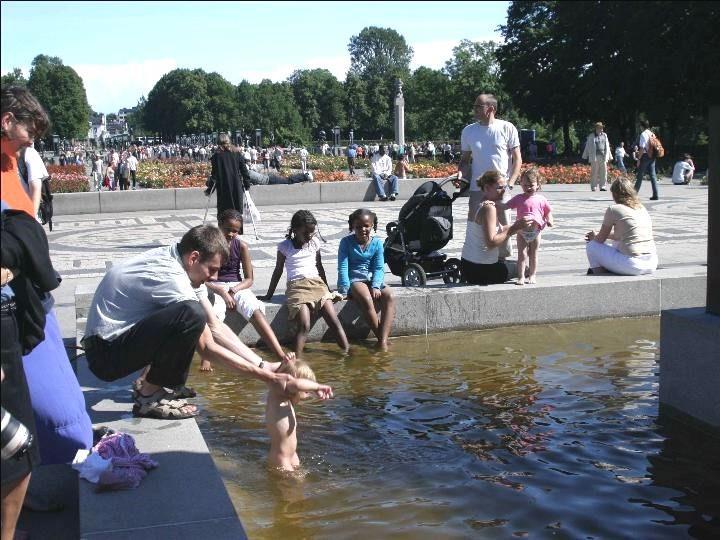
Next we were taken to the Fram Museum which turned out to be the house of the good ship Fram of which we had read so often in all the adventure stories of Arctic and even Antarctic exploration.
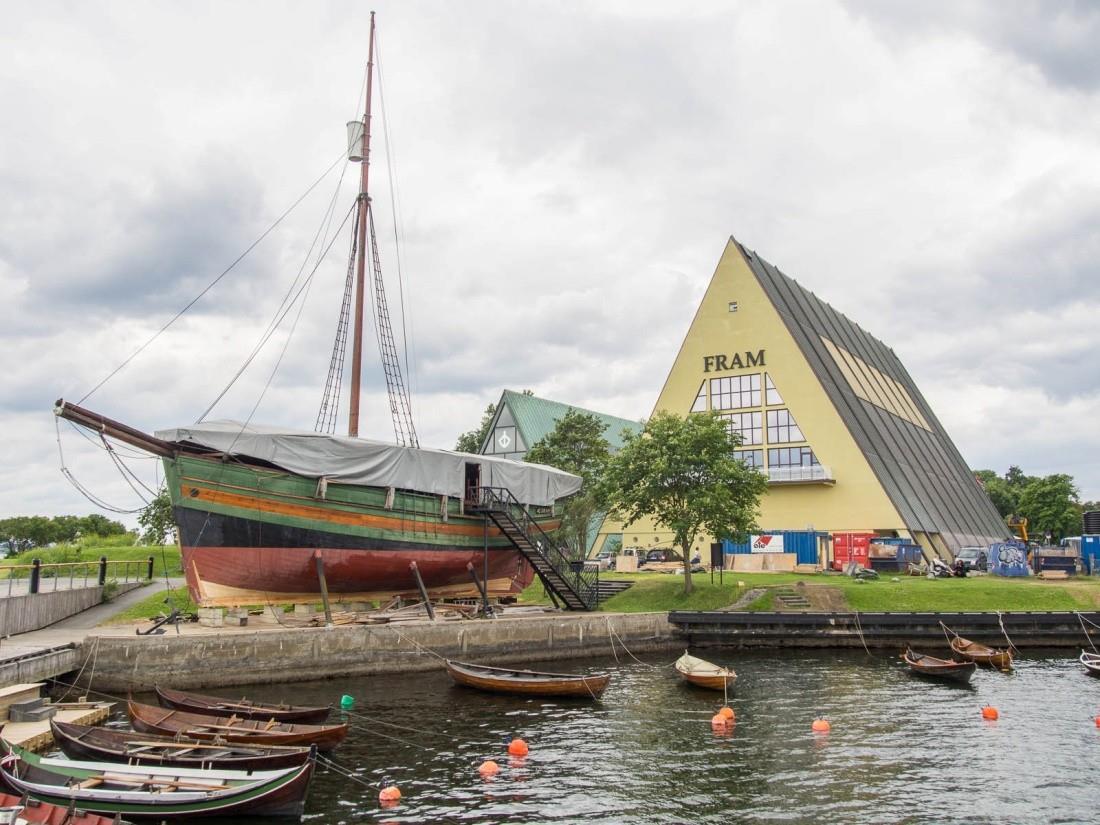
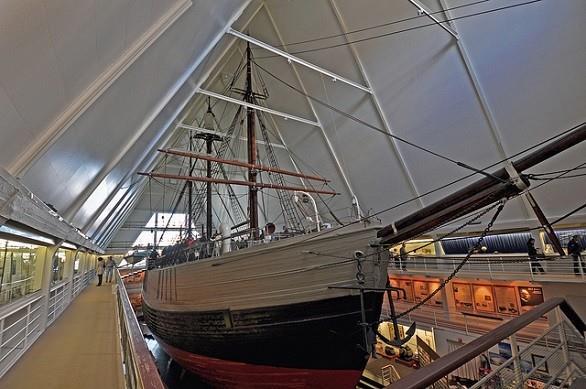
The ship was built at the direction of Fridjhof Nansen by a Norwegian of Scottish ancestry, named Caller. What a stout ship it was too. Its specially constructed hull of 18 inches of oak covered with greenheart wood withstood 3 expeditions to the Arctic and 1 to the Antarctic, often being caught in the ice for years and yet never breaking up. After Nansen had used it, others took it on various voyages of discovery as well & its mightiest adventure took it to the Antarctic with Roald Amundsen in his successful race for the South Pole.
Our welcome dinner and get acquainted “mixer” took place in the Theatercafeen Restaurant in the hotel & was delicious to people who had not eaten in 12 hours. We had cream of asparagus soup and then roast beef with carrots and turnips (shades of Iceland).
We avoided the potatoes and the bread and left well before dessert was served.
Now we are back in the room getting showered and ready for what we hope will be a good night’s sleep before we get back on an airplane to fly to Longyearbyen & the M/S Endeavor.
The 6:00 AM wake-up call found us finally sleeping soundly after a very wakeful night with long stretches of sleeplessness, courtesy of jet lag. The breakfast buffet was plentiful and we were aboard the busses back to the airport by 7:45 AM We were just a little more alert on this return trip so we were able to see again, with more details noticed, the lovely farmlands and carefully mowed fields. All the fields look like lawns because they are so closely cut. Anneke, our guide for this portion of the trip, told us about the various ways that the Norwegians try to protect both their moose and their human populations from disastrous meetings on the roadways.
We were instantly charmed by this wonderful people who would go to such lengths to protect their wildlife and we were totally amazed to learn that the Norwegian moose is just like the North American creature except for being smaller. The first ploy Anneke reported to us concerned “moose red lights.” Sensors were actually placed in the woodland areas favored by the moose to cross the nearby roadways. The devices were supposed to sense the presence of the moose (and other creatures as well) and give the automobile traffic a red light to alert the drivers to stop while the moose crossed safely in front of them. Well, this delightful device failed the moose just chose other places to cross the roads or the sensors failed to detect them when they did choose the “right” crosswalks. That attempt was abandoned only after a year of trials. Imagine such a patient and caring populace.

The next attempt to prevent car/moose meetings centered on “moose bridges.” The road builders designed earthen viaduct structures to permit the moose to cross atop the moving traffic. However, so far this method has not been an outstanding success because, again, the moose don’t particularly like their bridges and simply choose to walk across the road at another location. The Norwegians are nothing if not patient, so they have not abandoned this trial yet and are confident they are seeing signs that the moose are
“learning” the right crossovers. Imagine the people of this very small country (4.5 million souls) being willing to devote significant treasure to protect their moose as well as their peoples! Each bridge costs somewhere between $500,000 and $800,000 to construct.
Everything went quite smoothly at the airport and we were soon aboard our Braathens flight to Longyearbyen on Spitsbergen, the largest of the islands of the Svalbard. Spitsbergen means jagged peaks and these glaciated mountains we flew over certainly merit that description. We have learned that Svalbard means “cold edge” and that the region was mentioned in the Icelandic sagas of the 8th and 9th centuries; therefore the Vikings must have known about this remote archipelago on the edge of the Arctic Ocean.

The flight was spectacular during the last 30-40 minutes when we were flying slow and low over the remarkable landscape of this Arctic archipelago. Mountains appearing to be composed of sand piles, glaciers heading for the sea, snow fields blindingly white under the sun and blue sky! The inner walls of various cirques were dramatic with the lines of remaining snow looking like fossil plants espaliated white against the brown. Nunataks filled the upper sections of the glacial rivers of ice, sharp and jagged peaks emerging from their thick winter snow blankets. Occasionally, green mosses could be seen near the streams and in shallow ponds where melted water stood. Everyone was amazed at the extent and beauty of this Arctic scene. We flew for 30 minutes over the mountains and glaciers before reaching Longyearbyen and its airport completed in l975.
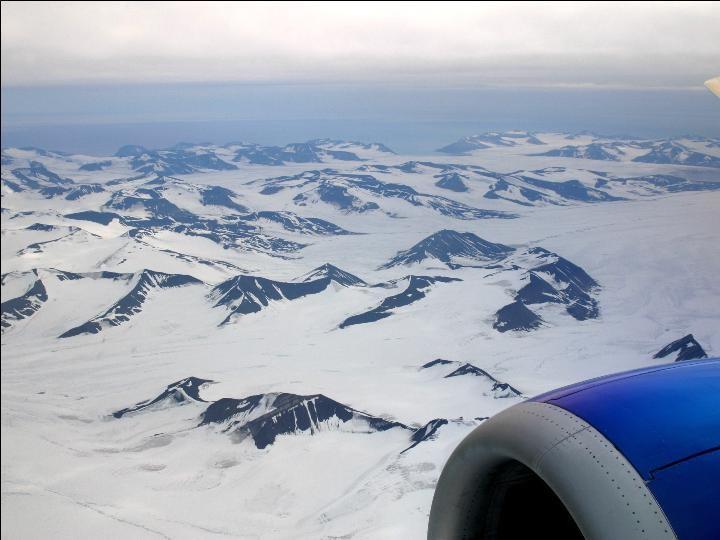
Upon landing, completely breathless with the panoramas we had just seen, we were met by Lindblad folks who loaded us on busses (after taking our passports from us) to have a “city tour” given by a 23 year old native of the little outpost. 1700 folks live in this strange little town, present because of the coal deposits but also because Norway wants a presence in this protectorate area. The coal has never been mined for a profit; instead the mines are always operated at a loss to the government of Norway. The region’s governor who is an appointee of the Norwegian government lives in this little town and is the real power here over ecology and environment, business practices, all legal matters public or private and infrastructure.
The town has a hospital with 3 surgeons, a post office, hotels, a school, a church, a branch of the University of Norway, a sports facility, several stores, and many kinds of housing from large “apartment” houses to individually owned places (becoming more prevalent in recently years). An architectural board determines the colors that all dwellings and other buildings are to be painted all to relieve the relative colorlessness of this area, particularly in winter; therefore we saw houses of yellow, pink, brick red, blue, brown, green, and lots of other shades and this array of colors certainly does much to improve the rather stark appearing town built on gravelly sand permafrost with elevated pipes running everywhere.
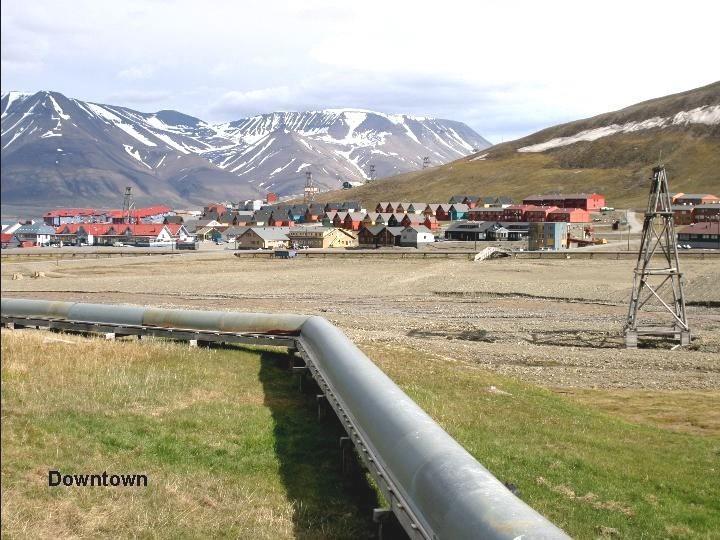







We toured the Art Gallery (where we bought our souvenir picture a wonderful polar bear drawing) and the local Svalbard Museum. Both were small but very interesting for lots of different reasons: curiosity about the history of the town and its mining heritage, about the Nazi German activities here, about what the people do to entertain themselves in this bleak and dark environment when winter comes. As they say up here, day lasts from about June to August and night takes the rest of the calendar to pass. We were also taken to the little downtown area where there were a couple of shops, a bakery, and a grocery store. Then the highlight of the town tour was a visit to the polar dog kennels and a little further on down the same road (there aren’t many here) we saw the town’s only road sign though it was meant for all of Svalbard, The sign warned about polar bear crossings on the roads and anywhere else they wanted to be. They are protected and have been since l972.
Finally, we were taken to the M/S Endeavour to find our cabin where our luggage awaited us. Very shortly afterwards, we had lifeboat drill and a welcome aboard champagne party in the Lounge. Then it was back to the cabin to unpack before going upstairs for a meeting with Expedition Leader and his staff as well as some key people on the ship. Supper was a 7:30 PM and it was delicious. We sat with John Stepplestroesser, a geologist and one of the naturalist staff. A large and rather self-important fellow, he nevertheless had some interesting stories to tell about his life in Antarctica, Russia and the Svalbard, exploring for coal.
Fog rolled in during dinner which rescued us from having to go up to the Lounge or Library to watch the marvelous scenery roll by as we had been doing before supper. Sowe got back to our cabin about 9 PM and will be glad of another early night even though the sky is pretty bright outside our very small porthole.
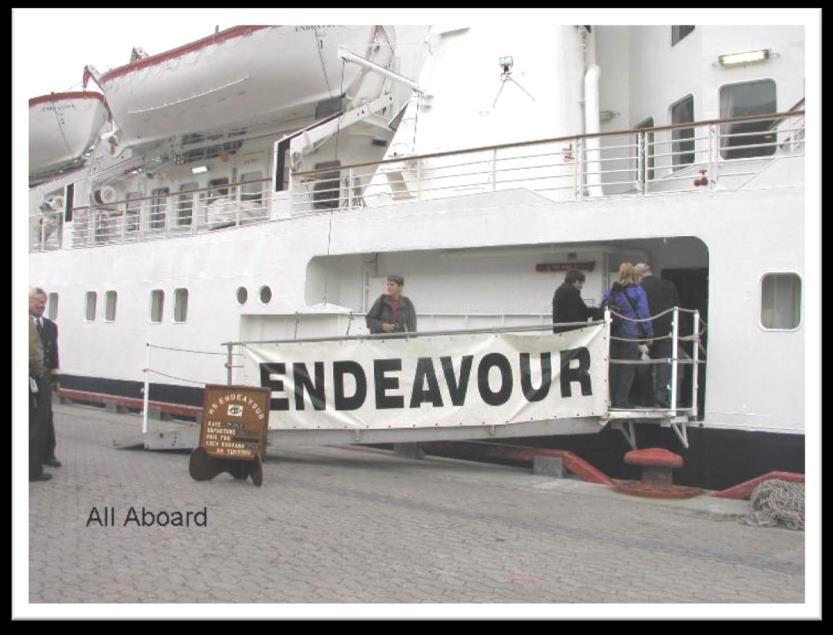

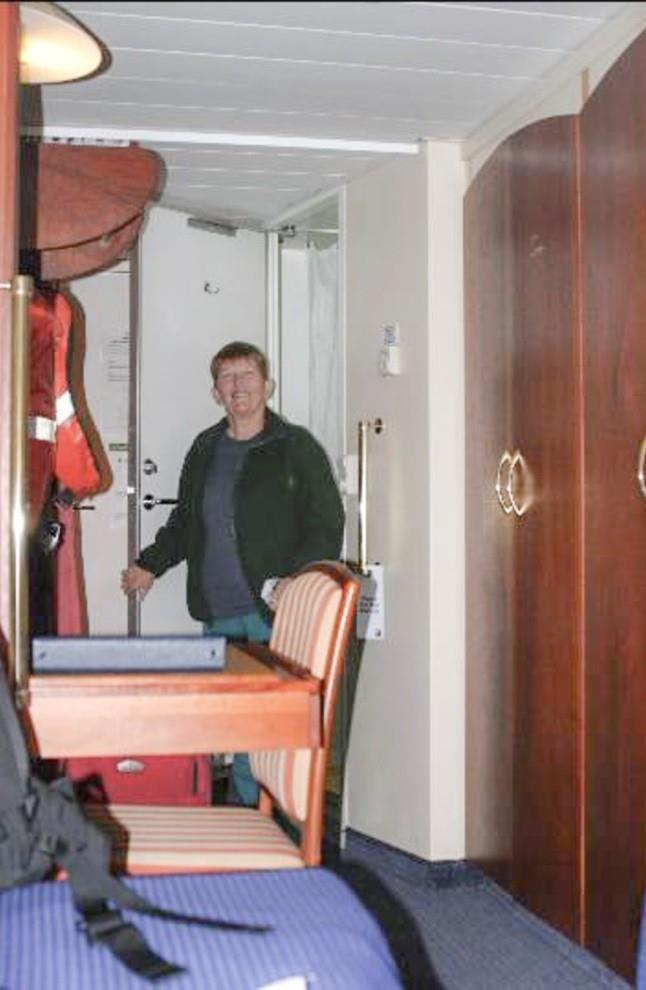
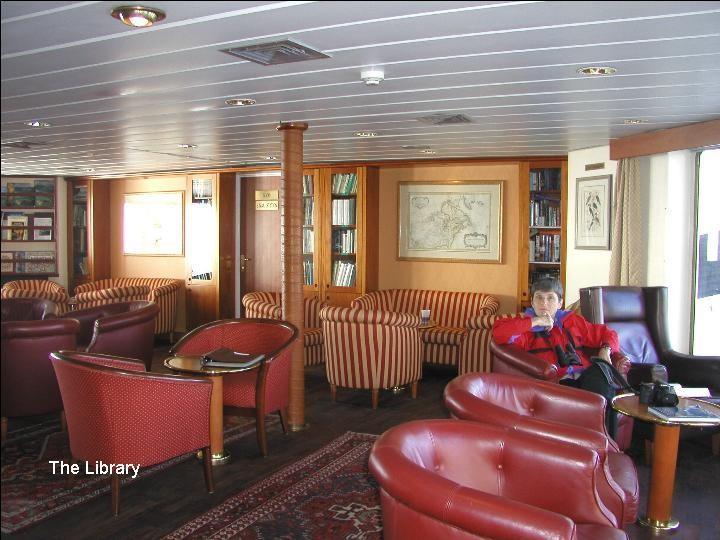

On first peering out of the porthole this morning around 7 AM, we were still in the fogbound world and could see very little except the waterline which is just a bit below our window. However, we got up & dressed and headed for our 7:30 breakfast buffet. By that time, we were in a glorious setting under bright blue skies and surrounded by marble “peaklets” and sedimentary sand hills. Birds were raucous on the cliff faces and the sea was smooth as the granite statues in Vigeland Park. Wisps of fog meandered about the scene, but stayed low and gauzy. Our view was magnificent and the weather was actually quite pleasant probably about 40 degrees.
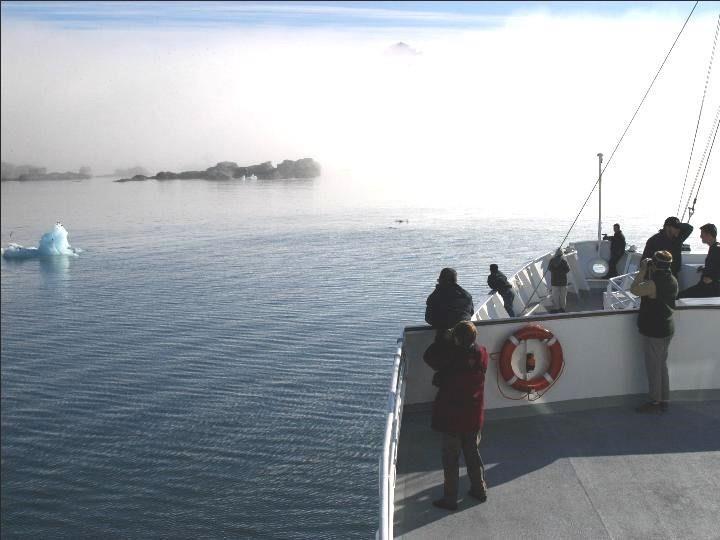
After breakfast and gawking at the scenery, we met in the Lounge for a briefing about our first onshore activity and how to behave in polar bear country. Then we were sent to our cabins to don the Wellys for the first time. Ralph informed us that here in the Arctic, every landing is a wet landing so we need not even ask. Zodiacs ride the same in the Arctic as in the Galapagos or Antarctica. We landed near an old trapper hut near the shore and divided into the groups that would climb the hillside and those wiser folks who elected to walk along the shore.
That was a rather tall order on the clamber up the steep, rocky, moss-covered hillside towards the bird cliffs. But we managed and got to the resting spots with the others. It was a challenging hike however because it was quite steep and footing could be tricky.




It was curious to be led and followed by men with serious-looking rifles over their shoulders and flare guns in their pockets. Also, there were wandering lookouts everywhere similarly armed. We were told to stay in our groups always with no straying or lagging allowed.
At our first stop, someone in the group looked out into the side bay at a large skerry with a W-formation cutting partway through its blackness. There to the right of the cut was our first polar bear! He was climbing about on the rocky formation and then took to the sea for a swim. Quickly, there were naturalists tracking him in Zodiacs as we continued up the hillside. We were beneath Barnacle Geese flying about, Kittiwakes and Guillemots nesting in the niches and ledges of the face, looking alertly for Arctic Fox. Of the foxes, we saw nothing, but we did learn something about the bird life and examined the beautiful and dainty little tundra and moss flowers: whites, purples, pale pinks.
The mossy patches were spongy but supportive and we felt a little guilty walking on these little tussocks. The grass was a bit more slippery but gave good footing as well. Rocks were continuously being plucked out of position by our boots and that was a bit more unsettling. However, we made the climb up and the steep descent without incident.



The trapper cabin was very small, dark, and divided into three basic rooms: an entry way, a kitchen/stove area, and the bunkroom. There were windows surprisingly enough. The whole basic structure was covered with tarpaper which is replaced on a yearly basis due to the high winds and the clawing of polar bears.
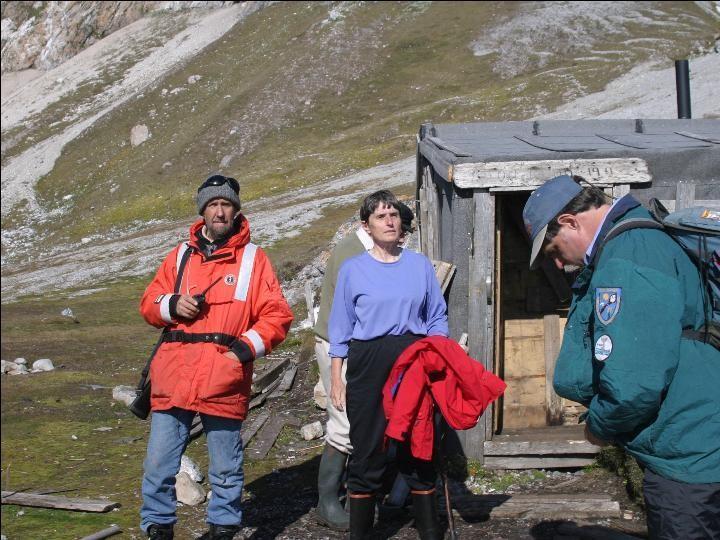
It was not really imaginable to think of spending a whole year in that hut, especially during the 4 months of complete darkness. Stefan told us that trappers had to be hardy in mind and body, inventive and clever at repair, and ready to stay focused and constantly busy even on the worst days. It was suicidal mentally and physically to “rest” on a single day. Two men could not share a cabin over the long year since tempers would fray and murder might result. As he said, “these men did not ask their best friend to accompany them for the year.” There are still trappers’ cabins all over the Svalbard but no one is allowed to hunt any animals. There is one diehard trapper who could not adjust to the urban world and he stays in the Svalbard in one of these huts. However, he now makes his living by playing the stock market thanks to his computer and internet connection. He actually is making more money than he ever made in his trapper life. Imagine someone sitting up about 200 miles from the North Pole in the middle of Arctic Ocean on a tiny scrap of line making his living playing the stock market. What a brave new world!
During our Zodiac return to the Endeavour we also spotted a Bearded Seal in the water. His head above the water surface looked enormous to us but we never got a really close look at his body since he stayed low in the water. We saw Black Guillemots (which have a large white triangle on each wing folded on their backs) as opposed to the Common Guillemots which do not. We were also informed that all the driftwood and even lumber that we had seen and would be seeing on our landings came from Siberia via the big rivers there which emptied into the sea and then were brought to Svalbard by the oceanic currents. Observing this phenomenon was one of the factors which led Nansen to his ideas about the circulation of the waters of the Arctic Ocean and then led him to believe that if he allowed a ship to become frozen into the ice at the proper point, it would be swept over the North Pole by these currents. The theory was interesting but it failed to bring the Fram to the Pole; however it was the beginning of the study of oceanographic circulation and currents,


The views from the boat were so commanding that it was hard to break away for lunch but of course we did and it was delicious and we were quite thirsty too. As we were finishing our lunch, Ralph received a call from the bridge and then we were told to go outside as quickly as we wished because a bear had been spotted on the ice.


He was a big fellow though quite far away. Now we understood why we were instructed to look for yellowish fur balls when bear-spotting. When the bears are wet, their black skin is seen clearly through the fur and the bears look very dark against the ice. As he dries, his color becomes less dark but not white it’s more yellow-ochre. The boat slid towards him but he was quite unimpressed and unconcerned with us. He was hunting seals. There were two Ring Seals lounging on the ice near a lead who seemed at first to be unaware of his stalking them. We wondered if we were going to see nature “red in tooth and claw” but the seals suddenly saw him and plunged right into the open water.
The bear was disappointed but Magnus told us that was not unusual since polar bears are only successful in their hunting about 2% of the time. Looking down at the ice, we decided it was “rotten” because there were many holes in it where the sea water boiled up and over the sheets. When the ship came through it sent cracks along the ice and parts would turn over so that we could see that it was about 4 inches thick. It would not have held us up as it did the bear. We saw his tracks in the ice and his feet are huge, like webbed feet, and he distributes his great weight over 4 points rather than two. The ice looked rather like soapy suds as we looked down on it.
Our bear continued hunting and demonstrated yet another method he uses still hunting. When he finds a breathing hole used by seals (his favorite food by far), he sits next to it patiently with his nose pointing towards the approach from under the water and waits, sometimes up to 24 hours, for a seal to emerge for a breath of air. Our fellow however must not have been that hungry because he tired of the still hunting rather quickly and went on walking across the ice. When he reached the lead in front of him, he slid right in-nothing like how gingerly we get into the much warmer water in our pool. He swam efficiently and it seemed pretty fast to us as well, but Magnus told us that the seals can easily out swim him.
We also learned that beluga whales sometimes tease the slower polar bear in the water by getting underneath him and blowing bubbles which really freaks him out. Walrus also sometimes harass the bears while they swim because even those big fellows can swim much faster than the bear. Our wonderful “gyro” binoculars were perfect for the long viewing time we spent watching this big fellow on the ice. What a wonderful day two polar bears in perfect weather and sea conditions.
Our intention to read for a while was rudely but happily interrupted when Ralph announced that there was a Bearded Seal on an ice floe dead ahead. We jumped up and ran to the top of the ship and there he was. What a strange looking guy he was too. We think he should be called the “whiskered” seal instead because he has a Teddy Roosevelt mustache which makes him look rather like a walrus.
He is a very round and fat fellow too with front flippers that look too short for his body. He is a grayish color except for a reddish brown face and head. No wonder he can appear so comfortable on an ice bed; he is rolling in blubber which tends to make fat wrinkles on his body below his shoulders along the back. He was very aware that we were trying to sneak up on him and was wary but he really didn’t care. He lazily looked at the huge boatload of humans staring out at him, aiming binoculars, cameras and spotting scopes at him and he curled up and went sound asleep.
Another little bonus was seeing a semicircular arc of Barnacle Geese swimming in close formation in front of the ship. They stayed ahead for a bit but we began to worry if they were going to try bow-riding like the dolphins. They didn’t though--they pulled over and let the Endeavour pass them on the left.


Sea kayaking lessons were next on our agenda because the Expedition Leader announced that we would never find more perfect conditions for indulging. It didn’t sound too complicated so we signed up to go. Our rain suits and Wellys once again were perfect. The kayaks are large yellow inflatable craft which are virtually unsinkable unless you do stupid things like getting too close to a bergie bit that rolls or run aground too close to shore. They have the most efficient and easy way of getting folks into the kayaks too. There is a platform placed near shore which is about a foot submerged. The kayaks are slid over the platform and the paddlers climb in from the Zodiacs quite easily with the crew and guides keeping the kayaks from slipping away from the awkward and slow.
What a super experience it was too paddling around in the beautiful bay surrounded by mountains with great white clouds radiating out from their peaks, deep blue sky overhead, bergie bits and growlers floating all around. The water was so smooth it looked like liquid silver rolling away from the “prow” of the kayak. We could hear the roar of waterfalls coming off the tidal glaciers as they tumbled in icefalls from the mountains’ steep sides. There were black guillemots bobbing along beside us as well.
The quiet was so captivating too because you could almost feel like you were enjoying the bay by yourself. A good laugh was had when Kay tried to point out something interesting dead ahead and Lois could not find it. Finally, after many explanations and directions, she saw it was a very large cruise ship which was in the channel out in the middle part of Hornsund Fjord (it could not have come into the area where we were trying our paddles). Another wonderful sight was the patterning of the remaining snow in the bowls of the cliffs and peaks we were seeing as we floated along. The streaks of snow looked like lightning bolts against the dark brown “sky” of the mountains and cliffs. We loved this experience and will want to try it again when the conditions are right again.
Sat at dinner with John S. again and heard wonderfully interesting stories about his life and experiences in polar places, especially the South Pole region, including the Russian station of Vostok which sits on the huge fresh water lake that scientists are trying to figure out how to explore without contaminating its waters. There are wild speculations about what they might find once they enter the enclosed lake: old life forms, microbes, or even sterility? No one knows, of course. He also talked to us about the difficulties of running aircraft on Antarctica as well as other machines like tractors and trucks. Airplanes are by far the most difficult and simply cannot be flown during the austral winter months. His stories were all plausible and entertaining. We went to bed around midnight and knew that there was plenty of light outside but lots of fog too.
Today we awoke to a world outside our porthole that looked like a bale of cotton. The fog was thick and it would not dissipate for many hours. That seemed pretty obvious and even Ralph, our EL, reported that we might as well relax after breakfast and figure out what to do with ourselves because we seemed to be in some pretty thick stuff.
We read a while and Kay worked on the pictures and then we went to lunch which was also an interesting experience because we ate with the ship’s doctor. He was enlightening regarding what special training he had to have before signing on with Lindblad a week with the Coast Guard learning firefighting techniques and personal survival. He also told us that Lindblad doesn’t want surgeons, only internists & family practitioners. Why?
After lunch we read some more and then learned that we were approaching a huge ice cap and glacier formation on Northeast Land which would be explored by Zodiac cruising. The ice cap is the second largest in the Northern Hemisphere after Greenland’s and would take 20 hours to completely circle in the Endeavour.
Our Zodiac ride was wonderful because the scenery was spectacular with icebergs floating around us and the world looking silver and gray with veins of blue in the glacier face. Something completely new to us: waterfalls coming right out of the glacier wall. Enormous amounts of water were pouring through round holes in the ice, through slits in the face, and leaking out the bottom at the tide line. We'd never seen anything like it before and our Zodiac driver told us that just last week there were no waterfalls there!



Here we were out there in our open Zodiacs, when suddenly another Zodiac approached with a huge yellow flag flapping above the stern. Wonder of wonders! It was the “hot chocolate delivery” boat. Our hostess gave everyone the choice of plain hot chocolate or hot chocolate with whiskey. Well, we didn’t want to ruin a good cup of hot cocoa, so we took ours “straight.” What a great surprise!

It was a treat to be in Magnus’ zodiac as he was full of wonderful stories about his experiences in Africa, Kazakhstan, and in service with Lindblad. He knew much about the early explorations in this area and was good at sharing them with us.

Meanwhile, the cold but beautiful seascape all around us was breathtakingly scenic. The glacier face looked like carved Carrera marble friezes and the icebergs were endlessly different in their shapes and sculptured features. The sky was gray and the fogbank stood back away from us for a while so we could enjoy this enchanted place in the Arctic. Birds flew along with us and skimmed the ocean’s surface with incredible ease. Some even landed in the cold seawater and looked perfectly content.
Back on the Endeavour, we had about half an hour before “recap” in the Lounge. We came in little late and got in on a wonderful story about a Norwegian who was helping to man the radio station on Bear Island which is a bit south of the Svalbard but still included in the Treaty. Since the radio station is really not necessary except as a presence in the area (for political purposes), the men on the station often relax, drink a little and play contentious and raucous card games. One fellow went outside to check some equipment and when he turned to come back inside the stationhouse, he realized that there was a polar bear between him & the front door. When he tried to go around to back of the building, he discovered another bear. Feeling pretty desperate, he ducked into a tiny storage shed and slammed the door. One of the bears was right behind and began
scratching and clawing at the door and the sides of the shed. Meanwhile, he was screaming and yelling and gesticulating wildly through the windows to his buddies who continued drinking and playing cards, laughing and talking. Though his attempts at catching their attention grew more and more frantic, he made no headway at all. Outside the shed, the bears were also making more and more determined efforts to get inside the shed with him! The man became quite unnerved realizing that he was never going to survive if he couldn’t get some help.
Suddenly, he remembered that there was a reserve short-wave radio set housed in the shed and he quickly got it ready to use. All the while hearing the scratching and tearing of the bears, he kept attempting to reach someone for help. Amazingly enough, the first person to answer him was a guy in Chile in South America. Luckily, he spoke English so the beleaguered Norseman was able to describe his plight. The Chilean radioed Oslo which then radioed Bear Island, reaching the partying men inside the main stationhouse.
The radioman in Oslo asked, “Is everything all right there? “Yes, course” was the answer. Then Oslo asked, “Aren’t you missing someone?” They then realized that their buddy was indeed not with them. And that is how the poor man was finally rescued before the bears managed to pull down the storage shed!
This morning we were awakened by Ralph’s cheery “Good Morning, Everyone, Good Morning” at 7 AM. He reported that we had sailed back south during the night and were now at a point in the strait where a walrus “haul out beach” had been spotted and we were going ashore to see the big creatures. There was still fog around so the spotters weren’t sure whether or not we would be able to take any walks around the beach area, but we were asked to sign up quickly for the long, medium or short walk just in case. Kay rushed upstairs to sign us up for the long walk and then we had to be at breakfast by 7:30 since the long walkers would begin boarding the Zodiacs around 8 AM
It was much colder here (around 32 degrees F) than our previous landings so we bundled up appropriately. When we got into the Zodiacs we saw that the skies were still leaden, the fog banks were hanging around, the sea was choppier than we had seen previously and it was penetratingly cold. However, the landing went smoothly and we tumbled off the Zodiacs onto a very pebbly beach with stones bigger than golf balls but smaller than baseballs.
As we crept quietly towards the haul-out, the stones became smaller and by the time we were told to bend over sharply and get on our bellies to crawl up the little rise, the rocks were much smaller and quite comfortable to lie prone on. (Note from the vertically challenged: as I approached the viewing area, Stefan touched me lightly on the shoulder and said, “You don’t have to bend over!”)

Once at the top of the little rise, we could see about 25-30 big walrus all heaped in a pile just a few yards beyond us. Everyone was remarkably quiet and we all had sensational views of the sleeping creatures.
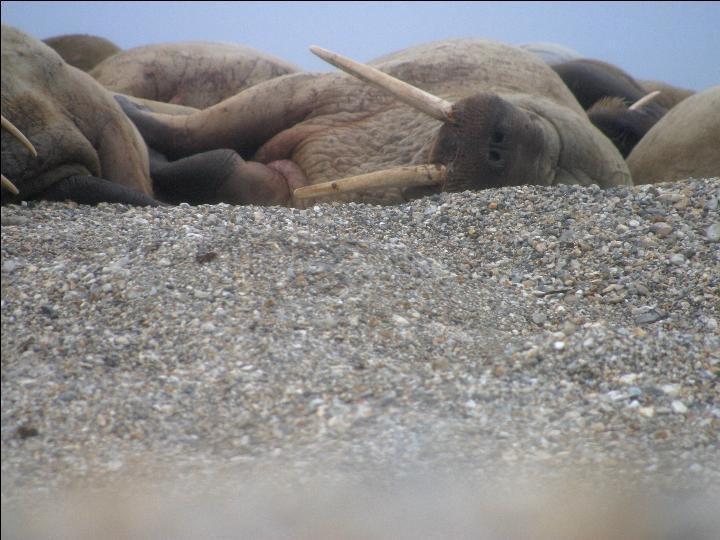
Huge tusks protruded everywhere in every direction: up, down, sideways, half hidden by other bodies, completely visible and even pointed skyward. These were males who are in a molting state and we were surprised to see their bumpy and very pink skins as the new skin emerges; some looked redder than others, almost bloody, but these were just farther along in the molt. They seemed somewhat testy and grumpy since occasionally one would try to switch positions and obviously annoy his neighbors who would rear up and
aim their tusks pointedly at the offender. They grunted and groaned and farted with both audible and olfactory consequences. Their wonderful whiskers were bristly and prominent and when in the right angle to our peering eyes, very impressive.


Brent (naturalist walking with us & carrying the big rifle) told us that walrus mostly eat clams which they are able to suck up from the mud at the bottoms of the seas and then force open with their very powerful cheek muscles and ability to force water into the clam shells. It did not appear that they could move very rapidly on land but when a big fellow would rear up and seem to look intently at the top of the little rim of beach where we lay “spying,” we all wondered about that conclusion because there wasn’t much distance between the warm pile of walrus (officially called a “huddle”) and us. Another fact we learned here is that both seal and walrus groupings are called “herds.”
After we had lay on the rocks for about 20 minutes, we got up to do some walking, though whether or not it was the long walk originally contemplated, we never knew. The walking was not difficult even though we did climb up some pebbly shelves (successive beach areas caused by the isotonic uplift of land as the ice shelf melted over the centuries). We saw amazing little flowering plants, tiny, but colorful. Some in pincushion shapes, others just staying as close to the pebbles as possible to keep out of the wind. The colors were deeply saturated and quite beautiful, especially in contrast to the stark surroundings: whites, purples, yellows and pinks. However, the rocks and pebbles were also of diverse colorations and markings too. The gray sky and overall ochre color of the beach provided a very satisfactory background to the flowers. Among the flowering plants were the mosses and lichens in very subdued colors except for a deep black lichen which contrasted dramatically with its surroundings.

Other objects on the shelves included reindeer scat and antlers as well as whale bones, chiefly bones of the skull, like jaws and the rostrum. Very white and weathered so probably had been there for very long periods of time, even centuries. We were also walked towards a 60’ cliff overlooking the sea but there was also a shelf full of snow between the top where we stood and the ocean which was a dull green and very cold looking.
On coming back to the Endeavour, our Zodiac ride was quite bumpy and rather exciting but getting back on the ship was not difficult. We rested a short while and then went up to the Lounge to hear Tom Smith’s lecture on Arctic wildlife. He has done considerable scientific work with many of these creatures for the Canadian government and with the Norwegians. He informed us that the Harp Seals which were the objects of protest by Greenpeace several years ago are now over-populated (about 7.5 million now as opposed to 2.5 million in the 80s) and are causing degradation of the cod supply for themselves and all other creatures including man who are dependent on the cod. Their ecological impact presently is very damaging. Though the market for harp seal pup fur has rebounded after having dropped dramatically during the Greenpeace protests, only 300,000 are taken annually which does nothing to control or reduce the population overall. Though the Canadian government did respond to the worldwide outpouring of emotion due to the very effective Greenpeace protest, it only postponed the time that the pups could be harvested. Now the pups must be at least 6 weeks old and in their “blue” period before they can be taken. Even execution methods were not really “improved” by the protest according to Tom.
The Ring Seal is the most important food source in the entire Arctic region and its numbers are quite secure according to Tom. Though many creatures eat the seal, from polar bears to man to walrus to other seals, they have easily sustainable numbers and are not endangered. He also reported that the polar bear population in Arctic Canada is stable even though the Inuit peoples are allowed to take 550 bears annually.
After the lecture, we went to lunch and enjoyed some table conversation with some fellow travelers who lent us a book called “Summer Light” by a fellow who hiked from Oslo to Bergen and took a trip similar to ours by boat as well as the voyage up the west coast Norway like the one we anticipate in August. They thought it would add to our enjoyment of this experience and the upcoming one. These ladies also told us about Grace: an amazing lady who appears to be in her 80s who lives on the M/S Endeavour throughout the summer. She simply buys fares for all 5 of the Svalbard trip which Lindblad runs each year. She was apparently at one time the Attorney General of Alaska and simply loves the Arctic scenery and the shipboard lifestyle. Now we are doing the diary and the pictures and waiting for another lecture at around 3 PM in the Lounge. We are running south to avoid being trapped in the ice and the seas are heavier than earlier.
Around 3 o’clock we thought there would be a talk of some sort, so we moseyed on up to the Lounge. Since nothing was doing, we went out on deck to look at the amazing vistas before us bergie bits, flat sea ice, and seabirds of several varieties. As we watched, we heard Stefan tell the bridge personnel that he had found a bear on the sea ice by using his spotting scope. Outside we dashed and were grateful for the warm clothing because we quickly picked him out with our binoculars too.

He was walking about on the ice floe rather aimlessly until we saw him move purposefully towards a depression in the ice and then we saw that he had made a kill. He was in process of eating the seal so he would come over and strip a couple of meat pieces off and devour it. Accompanying him were two ivory gulls, the first of these we had seen. We watched our Mr. Diner Bear for quite some time as he indecisively strolled about, jumped into the sea for a swim, came back to the kill site, and finally slipped off into the water again and began swimming at a 90 degree angle away from the ship. We lost him in the swells and turned again to check out the kill site more closely and also to appreciate the ivory gulls more.
Then it was time for tea in the Lounge while we awaited a talk on seabirds of the Arctic by one of the naturalists, Brent. He had a good slide presentation with excellent examples of all the birds he mentioned. Because the slides were so clear, we recognized a couple of birds we had definitely seen but were not sure of their names: the Glaucous Winged Gull and the Dovekie or Little Auk. The talk was enjoyable and it was good to see all the bird life that calls Svalbard home for at least part of the year.
Hike Cancelled by Bear
Ralph next got us all excited about going on shore. Dinner was moved back to 8 PM and we signed up for the medium walk (the long walk was already filled by the time we got to Reception). We ran back to the cabin to get geared up for the cold and since no call for medium walkers ever came we went eagerly to the “side gate” on the 200 deck.
We found that they had already started to load our fellow medium length walkers so we were relieved we had “come on down.”
We got into the Zodiac and settled ourselves for a cold ride over the waves to the landing site when suddenly Lisa (Asst. EL) told us to get back off the Zodiac because a bear had been spotted near the landing. Immediately all the Zodiacs were launched and the 30 long walkers already ashore were very efficiently returned to the ship as well as all the staff.
Of course, that meant that our evening shore excursion was scrubbed. We all watched the intruder bear way up on a rock face quite a bit away from the proposed landing site. However, we realize these animals can move very rapidly and so understand the necessary caution of Lindblad. One polar bear “accident” and that would be the end of the company. Not one of the naturalists understood what the bear was doing so high on the rock face because there are no rodents or birds in that area. They also believed that he could easily get down whenever he chose to do so. Guess he was just interested in geology.
With this disappointment, our Filipino buffet supper was moved forward again, but first we got to see some footage from the ROV which had gone undersea in front of the ice cap face we had visited yesterday. It was fascinating viewing the small invertebrate creatures floating in the water. The undersea photographer even found a couple of sea spiders for us. He told us about “marine snow” which is the white material floating in suspension in the waters no doubt made up of all kinds of detritus including waste materials from the animals, bodies of creatures both large and small in states of decay, accretions of minerals, etc. We would certainly like to see more from ROV filming later in the cruise.
We had another talk from Tom Smith on walruses but we had already heard much of what he had to say at another time. He spoke about walrus breeding, food consumption including clams and seals, molting, long period of lactation (18 months), their ability to fend off and even kill polar bears. They can weigh about 3500 lbs. & consume about 70m lbs. of food daily. Their suction strength is truly phenomenal and they are excellent divers, able to go down 150 meters and stay down 45 minutes.
The Filipino buffet was delicious and we enjoyed it immensely and totally. However, we are still left today with two questions with no answer even after having looked for some naturalists after dinner: 1) where do polar bears get their fresh water and how often must they have it? 2) How often do they need to sleep?
The captain told us he was going to head into an area the ship had not ever gone before, trying to find more landing places in the north. Then we would turn south again and search for the pack ice to find more polar bears for viewing. So we went to bed not knowing if we would sleep the night through or be called for more sightings.
Around 1:10 AM, we got our answer when Ralph’s cheery voice greeted us on the intercom with a good morning briefing about a polar bear in front of the ship. We hurriedly dressed and rushed up on deck (Kay made it up there about 5 minutes before Lois could get it together). It was 32 degrees and a thin rain was falling, but since there is no night viewing the surreal scene was easy. The bear was just waddling along, spraddlelegged on the ice, with no apparent purpose. The polar bear gait is typical since they all seem to demonstrate the same awkward-looking forward motion with lots of side to side balancing, no doubt to keep from breaking through the rotten ice. They also characteristically periodically and regularly turn their heads to either side, lift their snouts and sniff the air. The whole choreography of their “procession” across the ice appears to be inherent to the species. When we were sufficiently frozen from our outside gazing, we went back to the cabin to go to sleep again.
Lois never did get back to slumberland and was completely awake when Ralph next alerted us to another bear about 3 AM. He said this appeared to be a young bear who might exhibit some curiosity about us and stay around a bit longer. So once again, we struggled up and back into our full gear since he reported that real rain was falling this time along with the continued cold. Once more, Kay made it up on deck first and, when Lois joined her a couple of minutes later, told her that this bear was on his way away from the ship too. The only behavior he had exhibited other than ambling across the ice was to lie down at one point, roll on his back and wave his legs in the air. He did not indulge in this youthful game very long and by the time Lois had him in her binocular sights, he was wobbling across the ice again away from the ship and into the fog bank.
Apparently, it is believed that polar bears broke off, evolutionarily speaking, fairly recently from grizzly bears; but the few connections between the two other than the obvious “bearishness” suggest they have moved a long way off. Along about 4 AM, the strangeness of the life of “Ursus Maritimus” begins to flood into the mind with a clarity that you wonder you hadn’t felt before.
This huge animal lives in a world of silvers, grays, whites, glacial blues, constant fog and precipitation, and walking on water. His world is a frozen sea with lesser or greater degrees of rigidity in the ice depending on the season. He swims with great strength and without hesitancy in the icy waters of the Arctic Ocean and its various included “seas” and fjords, and bays. He depends upon the ocean for his food. Finally, it becomes clear that what makes one uncomfortable about his way of life is his four legs. It is not that he breathes air so do seals, walruses and whales. It is not even that he must earn his livelihood from the sea creatures so do birds and seals and walruses and whales. It is not that he can swim tirelessly for more than 100 miles easily during a day--so do the seals and walruses and whales. No, it is those four legs. They make it seem that he should be walking upon solid earth not out in a wilderness of sea water frozen to a thickness that he can tread upon.
The apparent surrealism of that life together with its loneliness, since he is most often alone, makes one feel unsettled, as though one can sense a deep mammalian commonality with him but also a gap so wide as to be unbridgeable even in imagination. The fact that science can demonstrate to you his perfect adaptations to this life, the ability to retain heat to the point that he actually must “cool off” periodically by swimming in the frigid waters, his extraordinary senses of smell and hearing which alert him to the presence of prey animals both above and below the water across enormous wasteland distances, that wide-based gait which allows him to walk atop ice so thin that a man would break right through none of that does anything to rid you of the discomfort of observing him actually living that life. It appears too alien to be abided and the bear too isolated and lonely to contemplate.
Finally, you must accept that he just doesn’t “look right” in his environment. Unlike the sleek seals, the ponderous and limbless walrus, the great whales, he just looks too “bearish,” too terrestrial, to have to live the pelagic life of other sea creatures. He seems too different from the other sea mammals to have a connectedness to them. No wonder his disposition is so fearsome!
Between Kükenthaløya & Spitsbergen
We awoke late today, July 11 (after a night of polar bears) to find ourselves in fog and rain near the eastern end of Heleysundet Strait. Following our rapid breakfast, we returned to the room for some rest and relaxation. Kay was the smarter; she took a nap immediately. Lois typed up yesterday’s diary notes and instead fell asleep in the Arctic Research Lecture by Tom Smith at 11:00 AM in the Lounge. Even though she did not hear much of the lecture, she was able to get the answers to some questions we had posed earlier about polar bear, seal & walrus sleep and about their need for fresh water.
Where do Polar Bears and Walrus get fresh water to drink?
The fresh water question was the easier of the two. None of them requirement fresh water in their diets because they create it in their own fat and then can metabolize it as the fat is burned for energy. So when any of these creatures is observed licking or chewing on ice, it probably is just curiosity or the animal may be starving so that there is insufficient fat in its body. The sleep question had a two-fold answer: Polar bears and to a lesser extent walrus do indeed sleep and for fairly lengthy periods of time. Both creatures are at the top of the food chain and do not need to exercise the constant vigilance of smaller prey animals. Therefore, polar bears often sleep after eating right next to their kill up to hours at a time. Walrus often sleep in their “huddles’’ when there are no young among them. Even the walrus is wary when calves are present. The seals, on the other hand, must always sleep with one eye open since they are quite vulnerable to the bears and walrus. They usually doze no more than a couple of minutes at a time.
After our midday “optional” feeding time (Ralph’s little joke), we were told that we were cruising in more open waters between Berentsoya and the island group of Kong Karls Land, looking for clearer visibility and for ice bears. We went in and out of fog but saw some phantasmal ice floes, bergie bits, and sea ice. We visited the bridge to learn a little about navigation and how the equipment works. We visited the Gift Shop and got a couple of souvenirs.

We patrolled the decks despite the rain and cold, trying to help with the bear spotting activities. A long time went by several hours before the cry finally went up that an ice bear had been spotted. As the ship maneuvered itself into a better position for viewing, we quickly ran outside too to get him in our binocular sights.
He was an interesting bear because the ice floe he was on was filled with hillocks and valleys (probably two year + ice we were told) and there were many times the bear would go behind one of the pressure ridges and be lost to view for a few seconds. However, once you had clearly located him, he was easy to find again because he was the color of a toasted macaroon frolicking in white meringue! He was the yellowest bear we have seen yet. And because his territory of the moment was so white, he stood out very well. However, he was not interested in being the object of all that staring from so many eyes and soon disappeared for good. Polar bear watch was declared officially over for that session.

So we began to study the many ice formations in front of us and found that they are truly protean in their variety. We saw flat floes covered with white “hotels and houses,” their shapes recalling the game of Monopoly, scattered all over the “board.”
There were double-decker bergie bits with thin flat discs floating over their submerged 2nd story which glowed vivid blues from beneath the shallow water. There were bowls of whipped cream, smoothed into mounds and hills of ice, looking absolutely edible. There were lacy filigree patterns floating along beside the boat. Some pieces looked like tiny Alpine scenes with sharp peaks above what looked for all the world like mountain tarns icy blue and reflective and ringed with snow.

Some of the floes contained tiny bodies of water that recalled the ponds craft folk create for their Christmas villages smooth, color arising from beneath a shiny surface, quite artificial looking and yet appropriate to call to mind winter ice-skating and fishing. Color was as various as shape in this sea ice universe. We saw glasslike pieces with the translucency of windows. There were some the color of clotted cream or melted butter. White itself comes in an amazing array of shades in nature just as it does on an artist’s palette or a home decorator’s paint samples. There were gray-white, blue white, ivory white, hospital white, reddish white. Finally the cold drove us indoors again and we had a cup of hot tea and a delicious Norwegian fishcake sandwich to warm us up. The Arctic seascape is dramatic, beautiful, austere, and pitiless and compelling all at the same time! Ralph announced that the naturalists were not thrilled with the type of ice we were cruising through and had asked the captain to switch course and tactics of polar bear hunting yet again. So now we are trying to go back north towards Nordaustlandet to find more “productive ice” where more polar bears may be spotted. So far the Arctic has been stingy to us we have seen only 7 bears on the entire trip, widely spaced and very far from the ship. Some cruises see many more animals and much closer up. So now we are waiting to get to the new area and hoping for more luck in pursuing the ice bears. Supper has been moved up to 7:30 PM and everyone has been encouraged to help the naturalists spot for polar bears as we continue to move to the northwest again.
Awoke to glorious sunshine this morning after a polar bearless night. But we all felt renewed & optimistic with the blue skies and sun-spilashed mountains and ice. So, right after breakfast, Ralph got us all ready for a shore excursion, again with the long walker, medium walker and short walker designations. The site was perfect for a smooth landing and we (medium walkers) headed off with Magnus. The first thing we saw that moved was two reindeer high up a slope near a snowfall patch. Without binoculars they were just two small dots, but with these wonderful Canon binos, we could see them quite well.

The land over which we hiked was boggy tundra, cut regularly with little or slightly bigger streams created by the runoff of the melting snow patches like the one where the reindeer grazed. There were many kinds of tundra flowers and we even saw two different species of tiny mushrooms. Sometimes the tundra growth looked like flat black stones but when stepped on they sank under our weight and metamorphosed into sponges instead. Here was a hike where the Wellington boots were a very good thing indeed. We saw the ribcage skeleton of a baby reindeer, probably taken by Arctic foxes shortly after its birth, according to Magnus.

As we hiked on, soon almost catching up with the “long” walkers, we saw three more reindeer, much closer up this time. It appeared to be a male, a female and this year’s baby. All were peacefully grazing on a low hillside, with the female looking particularly plump. However, because of the time of year, we figured she couldn’t be pregnant. The creatures are short-legged, stout-bodied, shaggy and small-antlered. According to the naturalists, this Svalbard herd is healthy and self-sustaining as well.
A few Snow Buntings appeared in front of us quite closely so we could see these pretty songbirds of the north. Like most creatures in the Arctic they are black and white - the best disguise for camouflage. Soon we also saw a purple sandpiper, a small shore wading bird who is the bravest one of his kind - he lives the year round in Svalbard. He is different also in that he is not of the usual coloration - nor is he purple. He is a duncolored bird with dark speckles, enabling him to blend well with the tundra ground he nests on. One of the courageous birds was apparently nesting on a hillock just beyond us and began to play the injured bird role to lure us away from the nesting site. It hopped pitiably across the tundra, appearing to be unable to fly because of an injured wing. The tactic certainly worked with Magnus, because he changed course immediately and said we would not walk up that rise so that we would not disturb the nest sites.


The cliffs rising behind the beach area and tundra ground were dolorites and rather dun colored too. The rock looked friable and unstable and there were many boulders and rocks strewn across the flatter areas. The cliffs were precipitous at the top with “alluvial
fans” crumbling down into less steep scoria and gravel piles. The snow clung in patches among the many cracks and crevices and avalanche chutes from the tops to the bottoms of the cliff faces.
Following our stimulating walk (Magnus made sure it was probably as long or longer than the actual “long walk”), we went back to the M/S Endeavour to get ready for kayaking again.

It was another day of perfect conditions for that sport: flat water, little tide, gentle breezes and glorious scenery. Floating beside us again were bergie bits and even three formations that might have qualified as icebergs. The shore in this area was covered with chunky blocks of stone piled atop one another but much lower than the cliffs where we had just walked. They appeared to have been carefully “cut” for use in construction. John (the geologist) told us they were the same material as the cliffs but that erosion (mostly caused by ice action) had ground them down into their present shapes.
When we looked further out towards the open sea and the pack ice beyond the cove, there were ice peaks rising above the horizon which looked like magical medieval cities of glass and silver, shining in the sun. The towers, turrets and spires, created by the ice, wind and water, looked ready to greet “Sir Knights” of old with banners streaming in the breeze and damsels leaning down to toss scarves of cloud and flowers of ice in welcome.
After lunch (a Swedish smorgasbord), we cruised into Bjornsundet (Bear Sound) to search for bears again and were rewarded when we saw four bears off in the distance. There was a lone bear and a sow with two cubs to lock in on with the binoculars. They did a lot of pacing around and the female seemed to be having a little disciplinary trouble with her two cubs since they didn’t appear to want to follow her closely enough. She would get out ahead of them and they would just sit together and watch her. She would then turn back and walk towards them. Sometimes they would reluctantly start out when they saw her coming back and at other times she had to get right up to them before they moved again. Perhaps they were fearful of the lone bear across the ice? However, probably not, or they would have stayed very close to their mother. Maybe, they were just adolescents getting defiant and trying to assert some independence. She was still “working with them” when we sailed away in search of bears closer to the ship.
As we sailed on, we saw several walruses hauled out on floes and bergie bits. Two of them were stretched out belly to belly sunning in the golden light and could hardly be bothered to lift their heads and display those wonderful canine tooth tusks (that is what the tusks really are).

But we could see them lazily scratching and occasionally lifting a questioning head at us. We have learned that at this time of year the walrus usually “huddle” to raise their skin temperatures to help the molt proceed more quickly. This is also why they scratch so often, both to relieve itching and help the molting skin slough off.
We saw a lone fellow who was much interested in us and demonstrated several ways manipulate those ungainly looking tusks. This was near Von Ottesoya (Von Otts Island).
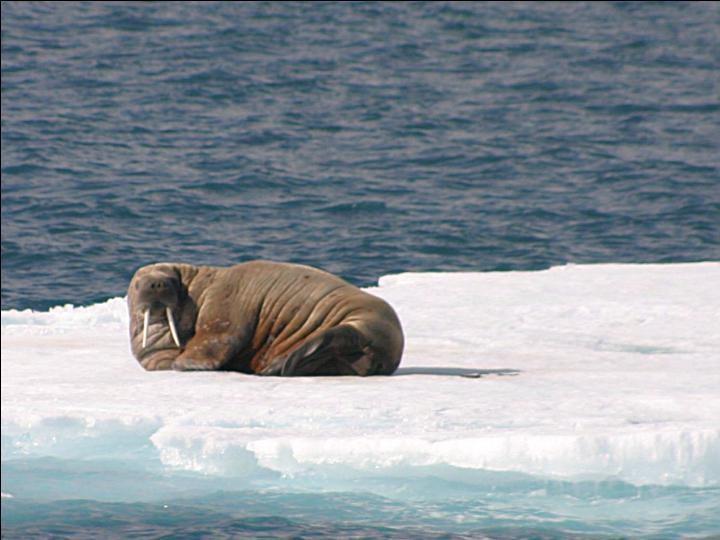
Most comically, he used them as props to rest his head upon. He would plant them firmly in the ice vertically & sleep in that fashion. At other times, he raised his head and tipped it to one side as dogs will when you speak to them and they try to understand you. The long tusks made the question mark on the walrus face a much more dramatic object of study, as they swept to one side. The faces of the walrus looked very manatee-like to us Floridians. They have big heads with small faces and bristly whiskers but kindly expressions. Because of the way the fat folds around their faces and necks, they also look like Shar-Pei dogs. The “squiggy” eyes are almost buried in the heavy skin folds. They are a comical looking creature indeed; however they are formidable predators and even the polar bears treat them with respect.

We kept on sailing through mysterious and fabulous ice formations, with the colors changing as the light altered. We had soft formations, hard-edged bergs, rotten ice, filigree ice, pressure ridges and melt water ponds on floes. We had golden glows and pewter shine. The crisp, clear air limned everything sharply so that sometimes the ice structures looked as if they had been cut out and pasted on a backdrop of blue sky and black ocean water. We moved along the ice cap we had seen earlier for at least two hours, and marveled at its height (about 750 meters) and length (150 kms.) as well as the extent that it appeared to stretch back from the shoreline.
After we had passed the ice cap, we came upon a strange sandy brown low shoreline (John S. told us it was “shale”) that suddenly transported us into a desert scene, except that this desert culminated at the Arctic Ocean shore with bergs and pack ice at the tide line. A very strange desert indeed. The clouds played charades above the ice and water sculptures, changing shapes and colors as rapidly as a kaleidoscope. All the while, the various beauty of the Arctic world was imprinting our memories indelibly.
Dinner came and we had still seen no more bears. However, as dinner was ending, we were told that three bears had been spotted on the ice pack and that we were maneuvering into a better position for viewing. We were in the west part of Eriksenstreten (Ericson Strait) in the pack ice at this time. This occurred about 8:30 PM and by now the light pouring down on the timeless scene was molten gold, tipping the edges of the ice
formations with honeyed hues. From far across the floe at the ship’s bow, we saw a mother bear and her two-year cub approaching nearer and nearer. Of course, we were holding our breaths willing them to continue their slow and ponderous way across the pack ice. The cub followed closely behind his mother, though at one breath-holding period, he seemed to lead her- in the direction we were all hoping for ever closer to the ship. However, she soon regained control and kept him behind her.
From then on, they moved only a little closer to the ship though they continued to cross in front of us. These bears were the whitest ones we had seen yet and with the binoculars they were clearly observable. All augmented eyes were trained on these two creatures. Most of us never saw the third bear who had been mentioned in the announcement at dinner. The interactions between mother and cub were fascinating to watch because they clearly communicated at times. In one amusing segment, they got behind a relatively short ice hillock and seemed to rest there, with a head coming up occasionally to see if the ship was still there. They would stretch their necks and peer towards us and then turn away, pointing their black noses towards the very distant shore. There was much stretching and leaning and playing peek-a-boo going on. It appeared from the position of the mother at one time that the cub may have been nursing, but it may also have been that she was just cooling her back off against her “ice chair back.” Later events strongly suggested the latter intention.
Finally, the female came from behind her little privacy screen and began walking transversely again. All the time we had been observing the bears we had also seen many seals up on the ice beside their breathing holes. All seemed to be alert and watching the bears’ behavior just as we were. Periodically, they would all drop into their holes though heads would bob back up to periscope around, locating the bears again. At last, the mother bear signaled to the cub to drop onto the ice and she went a little further away and began to “still hunt” at a breathing hole. They sat that way for a while and then the cub appeared to lose patience and got up to move around. Mother stood up and seemed to signal him again with a motion of her back leg to sit back down which he did immediately and did not move again.
Then the ship’s captain and the naturalist made a big mistake they decided that we should not further disturb the bears and began to back the ship away from the ice. While some folks continued to look and others drifted away, the most amazing thing happened which even many of the long time Arctic hands had never seen. The mother bear got up from the hole, walked apparently without purpose towards a tiny lead and within a split second sprang forward, crashing into the lead with all four legs stretched out and came up with a seal! No one had anticipated this activity but one lucky passenger was videotaping when it happened. The sow had given no warning that she was doing anything purposeful when she rose to walk and struck so suddenly that everyone was awestruck.
She pulled the hapless creature (probably a ring seal) up on a little ice hill where she and the cub immediately fell to eating at opposite ends of creature since they stood a little apart from one another. Stefan told us later that the seal was probably instantly killed
since the bears bite through their relatively thin-boned skulls. As magically as we had been told to expect, the ivory gulls began to gather almost at once but waited respectfully as the polar bears dined. And they dined and they dined their faces, chests and legs becoming more and bloodier as the 1 hr. 5 min. feeding went on. Meanwhile, some skuas arrived and they became testy with one another as they waited for their turn at the feast.
The nasty tempered skuas would fly at one another and jockey for a space closer to the kill site. They would huffily fluff their feathers and flap their wings at each other. The ivory gulls did not quarrel among themselves: they just waited.
Still another amazing thing happened. About ¾ of the way through his feast, the cub stopped eating and headed towards one of the melt water ponds and began drinking. All the experienced bear watchers among the naturalists were also surprised at this behavior since polar bears so rarely drink. He then licked his paws a bit and went to a second pond and drank some more. After that, he walked back to the kill site and began to eat again. The mother became restless at the site and kept looking to the left as if she expected an unwanted guest to arrive; certainly it was not the gulls and skuas who had her wary. She wandered a few paces away and sniffed the air and then came back to finish up. It was hard to believe that there would be anything left for either the patient or impatient birds.
Before we left this primal scene, the cub had sat down on all fours on the ice and began to wash his paws. We never saw the mother begin to clean up and wondered how they would ever get the bloody remains of their dinner off their white fur. “Out, Out, damned spot” and a scene so bloody that “it would the multitudinous seas incarnadine” were quotes that came to mind. What an unreal drama to have witnessed what a good mother/provider this sow was what an awful end for the hapless ring seal with its innocent face!
As though in memorial to this sea creature whose life was sacrificed so that two others might live on, the scene around them and us suddenly turned to liquid silver and the little peaks and edges of the ice bergs and pressure ridges shone metallically bright!
By the time we settled down in the Lounge to talk with some fellow travelers, we were stunned to see that it was 10:30 PM and it was as bright as high noon in Jacksonville. However, what a different quality to that “brightness.” We stayed up until 1:00 AM because we wanted to see the midnight sun and this was our first and last chance to do so as we had thick fog on all the other nights. Of course, there is really no night (darkness) at this time of year in Svalbard and there really isn’t any lessening of the intensity of the light except as it is modulated by rain and/or fog. This midnight sun casts an incisive brilliant light which sharply points up everything it touches. But it is not a flat glaring light. It is cool and transparent and almost unbearably delineating. It must be the Platonic ideal of “light”; the very reason God originally created eyes!
That miraculous vision of the world in high Arctic midnight sun made it very hard to pull ourselves away to return to our cabin with its tiny porthole for something so mundane (even though a mammalian requirement) as sleep.
Breakfast found us between Edgeoya Island and the east coast of Spitsbergen and we had been sailing all night at a good clip. It is a long way from where we spent our last bear viewing and midnight sun watching back to Longyearbyen and so we knew that today (Sunday, July 13) would be spent at sea without any chances for landings or sightings; of course there is no more pack ice so we wouldn’t expect to see any bears. They must make their living on the ice.
After breakfast, we had a presentation on polar bears by Stefan Lundgren, a Swede who has spent much of his life in the high Arctic doing various kinds of jobs including research, guiding, hunting, and now naturalist duties on Lindblad duties. He did not claim to be an expert on polar bears, however; he said he was synthesizing the work of many scientists including Tom Smiths who is on the ship with us. He spoke to questions of polar bear reproduction, feeding, denning (pregnant females only), locomotion (usually walk at 2 mph because that is most efficient for them and they do not produce excess heat at that stately speed), hunting, senses (smell, hearing, vision that is the order of their dependence on their senses), special adaptations (eye has a creamy layer which protects the bears and other sea mammals from snow blindness despite the intensity of light and reflection here AND fat storage and retrievability which allows the bears in times of hunger to recycle their nutrients, never having to urinate or defecate AND it is this ability which also makes it unnecessary for polar bears to find fresh water with any degree of regularity. He illustrated his talk with some marvelous slides of his own which showed his familiarity with the bears and his long years of observing.
However, the highlight of his talk was live film footage of a polar bear birth for which he could not take credit. It was part of a documentary on polar bears done on the BBC about three years ago. Some polar bear researchers had taken a pregnant female to an artificial snow den they had created in Germany so that they were able to film the birth and subsequent behavior of the mother and baby. The film was very moving because the newborn bear is so tiny next to its enormous mother (like a panda baby in relation to its mother) and yet she treated it with such tenderness and care. She of course was not eating at this time but the tiny baby fed voraciously and gained size and weight rapidly so that in a couple of months after birth it was able to emerge from the den at about 20-30 lbs. (it couldn’t have weighed even ½ a pound at birth). During the film, the mother was seen licking, stroking, and looking at her tiny blind helpless cub. She would emerge from her somnolent state and begin interacting with the baby and then slip back into her twilight realm of semi-sleep meanwhile, baby nursed on and on, getting bigger, fatter and stronger. What a harsh life they would face when they emerged from the birthing chamber: she to provide sufficient nourishment for herself and the baby and the cub to learn survival and hunting skills from his mother over the 2 ½ years he would live with her--all this despite the rigorous environment, the change of seasons which bring necessary alterations to hunting and survival skills. How good it is to know that despite these tough tasks and lessons, the Svalbard population of polar bears is doing well and is self-sustaining.
What a great effect that l973 Norwegian protection of the bears fromhunting and the subsequent Arctic Nations Treaty against polar bear hunting of 1976 has had on these magnificent maritime bears!
After lunch, we got all our packing done so that we were ready to put our red suitcases out whenever Ralph called for them. Packing really was not a chore because we just rolled up all the dirty clothes and put them in the “to be checked” luggage and then kept the few clean things out for the backpacks since we would need them with us at the airport hotel in Oslo. We relaxed, read, sat in the Lounge, and talked to a few people. Meanwhile the waters were getting a bit more rambunctious, but the captain assured us that when we rounded the bottom of Spitsbergen Island, the waters would smooth out.
Around 5 PM, Stefan had the lecturer’s dais again and this time he showed us pictures from his favorite springtime activity around Longyearbyen. He flies over from Arizona and meets a friend to go “ski-dooing” up a glacier behind the little town and on towards a cabin they share. It sounds like a grueling adventure since they must deal with hungry polar bears, many hours of complete darkness, significantly cold temperatures, primitive conditions which require melting ice & snow for water, paranoid bathroom visits because they must go outside the cabin and never know when they will meet a polar bear on their way there or back. The pictures Stefan takes of the strange light in the Arctic at that time (around April) are truly lovely and different from the kinds of light we were seeing. The land still locked in ice and snow is both beautiful and forbidding. His description of these excursions by ski-doo did not entice me to want to join him however. That’s just too cold, too primitive and probably too dangerous as well: not only polar bears menace the travelers of April; there are also crevasses in the glaciers, calving ice faces, blinding and disorienting fogs.
Sighting a pod of Fin Whales
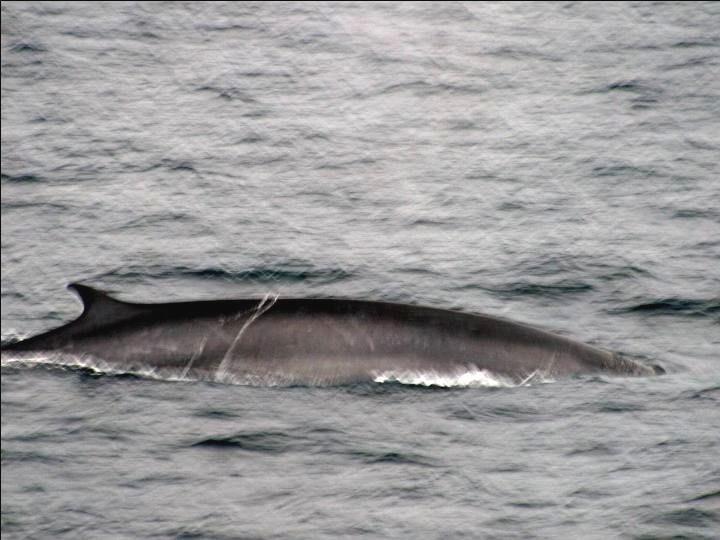
Sure enough by supper time, the seas were calm again which made us happy. We had intended all along to have dessert and bread at this meal (we had not eaten either of those things until the last day) so we were happy that we would not be bouncing along. Dinner was delicious as usual and the chocolate chip ice cream with chocolate syrup was well worth waiting for. At dinner, we were told that some Fin Whales had been spotted and that we should get up on deck as quickly as possible.
Up we ran and sure enough, the M/S Endeavour was floating in a pod of these enormous whales the second largest in the world (after the blue whale). They are particularly striking due to the great length between their heads and their tiny dorsal fin, almost at their tail section. There were perhaps 15 of the big fellows surface-feeding all around us and it looked like an orchard of palm trees had sprouted in the sea as we saw them blow spray into the air all around us. The spray was probably 20 feet high and fairly substantial in volume and it really did rise up and resemble a palm tree. Everyone was snapping pictures again and smiling. Ralph most of all, probably, since he was able to deliver a final “great sighting” to our group which had spent at least 3 full days in the fog (even today was overcast and foggy) and had enjoyed only 3 shore landings.
However, no one on this cruise seemed to be disappointed we had witnessed the quite unique polar bear behavior with the mother bear making the seal kill; we had seen 13-14 bears, including 3 cubs, we had been charmed by the toothy faces of the walrus, been thrilled by the midnight sun and the dazzling light displays! It was a high successful expedition filled with unique and moving experiences.
As my sister, Kathy, always says: “These cruises are a little taste of paradise and just when you get used to it, the trip is over and you are thrown out of paradise unceremoniously and without recourse.” And it's true. Sigh.
So we had our breakfast on Monday, July 14, put the red bags out for the porters, went to sit in the Lounge until the busses came to pick up us to take us from the dock to the little town center. While waiting for further transport, we walked about town for one last look at a way of life strange and peculiar to us Floridians. We did a little shopping; not much because things are fearfully expensive since everything has to be shipped in, and we took some pictures of Longyearbyen.
Happily, we also found a most delicious ice cream bar called a “Sval Bar” and it was so good rather like a frozen Snicker bar with ice cream added.
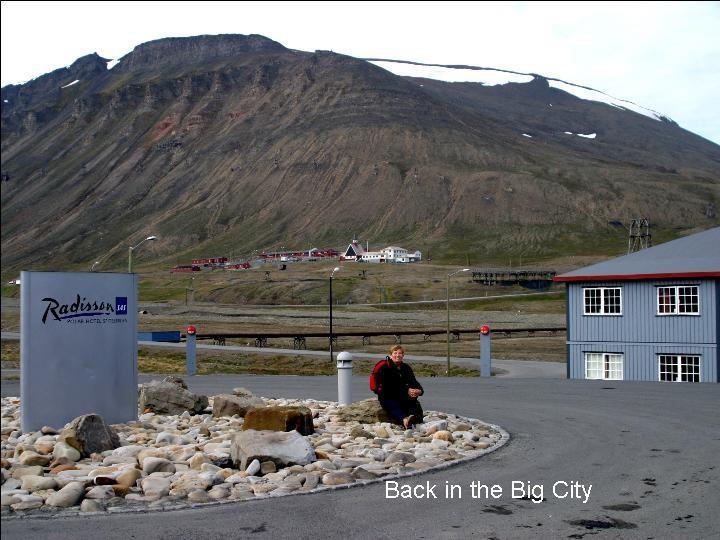

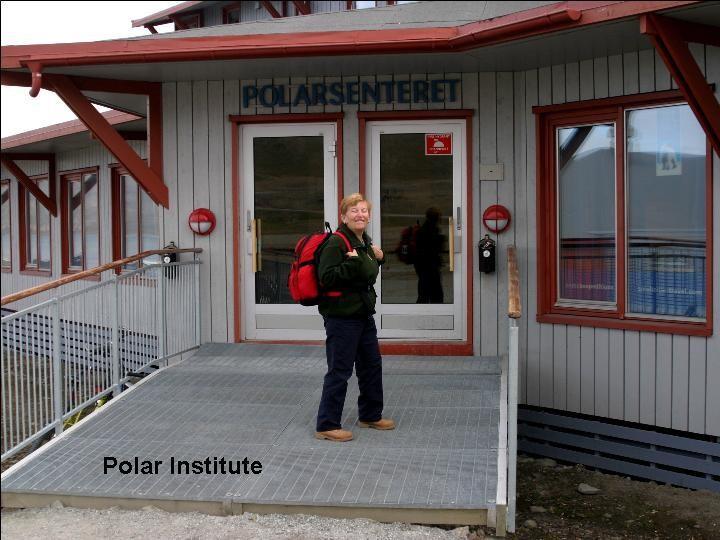



We were at the airport by about 1 PM, really just in time to see our friends Rikki and Jack Swenson, the photographic guides on our Galapagos trip, troop by to join the M/S Endeavour for the upcoming voyage. It was good to see them and they looked eager and ready to go on their own polar bear hunt.
Once back in Oslo, after a nice flight of just a couple of hours, we checked into the Airport Radisson and found it quite comfortable though strangely motionless. We were tickled at how quickly our legs had become used to the rolling of the ship and we felt like we were still on board even in the hotel.
Supper was at the airport pizza joint for a not too good slice of strange pizza. Then we clung to our still rocking beds and fell asleep after reading some. Next morning we had to be back in the airport by 9 AM after a free breakfast buffet at the Radisson. The hotel was just across a narrow street from the airport entrance so it was very convenient. Our trip back to Newark was uneventful and pleasant.
Someday, we will want to go north to the Ice Bears again, hoping for better weather and closer encounters with that majestic and beautiful Arctic animal! It’s wonderful to know that he is protected there and is increasing in numbers because of the protection. We will want to greet & photograph him again!